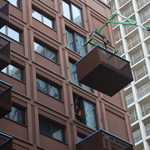Regen opportunities are significant even on a nonstop run, because tracks are seldom flat and braking is used in many places to govern speed - a train going full speed into a dip will gain speed very quickly unless some form of braking is applied. And then, it needs new energy added to go up the next grade. As well, with so much of the rail system being single track, even priority trains do have to slow down and stop to pass opposing movements.
Currently the railways have no choice but to waste huge amount of energy (and produce huge amiunts of carbon) that could be reclaimed - until now, the only option has been to string catenary, which has been too costly to justify.
So battery power has considerable promise… but it’s too soon to say there is a solution. Until there is much more intensive testing of ready for production locomotives, it’s still a matter of first proof of concept and then demonstration of ready to implement solutions.
The Wabco unit is still a very early design, Depending on how world dynamics evolve, it may take a long time for the stars to align. we are still at wait and watch mode in many ways.
- Paul




